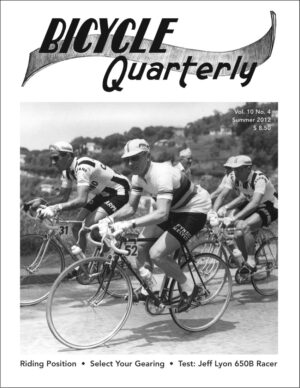

BQ 40 (Summer 2012)
$9.75
If there is one single topic that summarizes Bicycle Quarterly, it is the search for the best solutions. The Summer 2012 issue focuses on “ultimate” bicycles. Note the plural form: There seem to be as many “perfect” bikes as there are individual riders.
What would happen if one made a racing bike, but with truly wide tires to improve the handling and comfort? Jeff Lyon built such a machine based on our suggestions. Is it really the “ultimate” racing bike? We tested the bike and rode it for hundreds of miles to find out.
In 1929, the British cyclist and inventor Vernon Blake assembled his own “ultimate” bike. Learn more about this fascinating man, and find out what he considered essential for traveling long distances at great speed!
Creating your “ultimate” bicycle can be a slippery slope, as I found out when I worked on my new bike. When specifying the bike, I decided to use the best components, no matter whether they were easily available or not. In the end, almost every component was modified or custom-made to create a bicycle that is coherent, aesthetically and functionally, rather than a collection of dissimilar parts. This last part of a three-part series examines the components of this bike – why they were chosen, how they were made or modified, and how they work on the road.
Creating your “ultimate” bicycle requires knowing what you want, so this issue includes a “How To” section. We trust that our readers know how to fix a flat and how to close a quick release correctly, so we examined topics that often are overlooked, including:
Riding position and power output:
Both low and upright positions can be very comfortable. Which one works best for you depends on your power output, riding style and other factors. Get comfortable on your bike by learning which position is best for you!
How to select your chainrings:
Your gearing should match your riding style and terrain. We look at different gearing options and explain for whom they work best. How does your “base gear” affect your gearing choices? How does your gearing affect your rhythm in hilly terrain? Why are two chainrings a great choice for some riders, while others benefit from three?
What makes a bike fast?
How much slower is a fully equipped bike with fenders, racks and lights than a stripped-down racer? We look at the physics involved and test several bikes against the clock on a local hillclimb.
No issue of Bicycle Quarterly would be complete without an inspirational story about cycling culture. In this issue, we report on the working bikes of Florence, Italy, where riders and small shops have created novel solutions for carrying loads on bikes that are ridden daily in this beautiful city.


